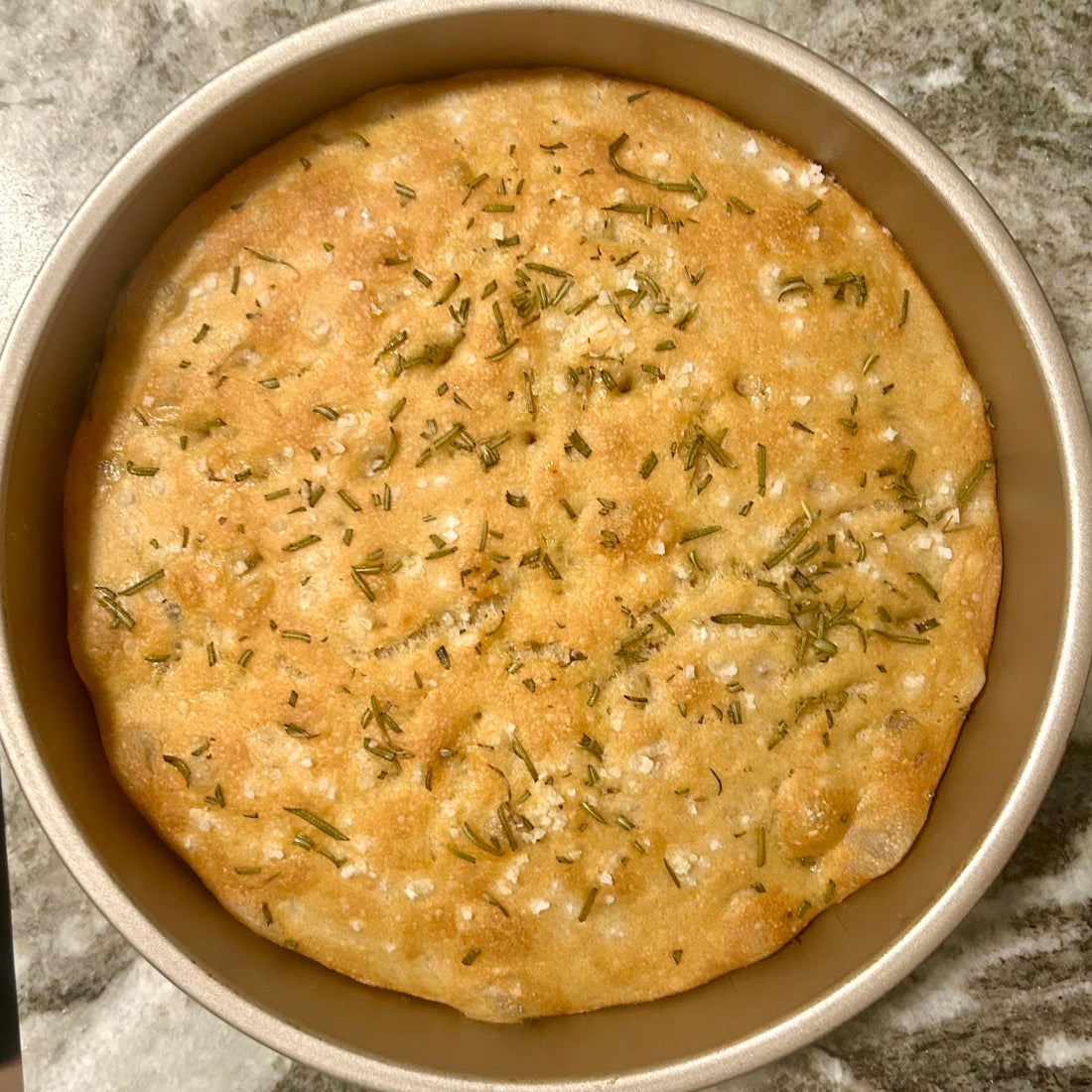
Rosemary Focaccia
Time: 4 1/2 - 5 hours (Mostly hands off time)
Skill level: Beginner
Yield: One large loaf of focaccia, about 8 slices
Ingredients
- 250 g Artisan Bread Flour
- 250 g lukewarm water
- 7 g active dry yeast (one sachet)
- 10 g maple syrup (or white sugar)
- 50 g olive oil (I use Fat Gold Standard, but any fresh olive oil can be used)
- 7 g kosher salt
- Finishing Salt
- 2 sprigs fresh rosemary, chopped roughly
Equipment
- Scale
- Medium mixing bowl with lid
- Optional: small mixing bowl with lid
- Small measuring bowl
- 9 inch round cake pan
Instructions
-
OPTIONAL POOLISH: The night before mix 25 g bread flour, 25 g water, and a pinch of yeast¹, taken out of the total recipe amounts, in a small mixing bowl until thoroughly combined. Cover with a lid and sit at room temperature overnight.²
- Start here if not using a poolish: Mix together water, yeast, and maple syrup in medium mixing bowl and let sit on counter for 5 minutes.³
- If using a poolish, add the poolish to the mixture from step 2 and mix thoroughly, then add the bread flour and mix with your hands until a very shaggy dough forms. The dough will be very loose and look like it won't come together. Trust the process. Cover and let rest on the counter for 20 minutes. ⁴
- Add the kosher salt and 15 g of olive oil. Work the dough through squeezing and kneading until completely mixed. You shouldn't feel any grains of salt when done mixing. Cover and let rest for 30 minutes.
- You should have a wet, but more cohesive dough that has risen about double its original size. With damp or lightly oiled hands pinch the dough with all your fingers and lift until the dough feels like its about to break. Fold this flap to the opposite side of the dough, rotate the bowl 1/6 of a turn and repeat until you've gone the whole way around the bowl⁵. Flip the dough ball over and then cover and let rest for 30 minutes.
- Repeat Step 5 two more times.
- Add half the remaining olive oil to the cake pan and rotate until the entire bottom and sides are coated in oil. Move the dough ball into the cake pan and gently press the dough to the sides of the pan. If the dough will not stretch to the sides, then cover the pan with your mixing bowl and come back in 10 minutes to stretch it the rest of the way. Let the dough proof covered on the counter until more than doubled in size, around 1-1 1/2 hours. Start preheating the oven to 450°F (230°C) with the rack in the center.
- When almost ready to put in the oven, lube up the tips of your fingers with olive oil and press firmly and almost to the bottom of the pan. Repeat until the whole loaf is docked with holes, then pour the rest of the oil over the loaf. It's alright for the oil to pool in the fresh dimples. From here, sprinkle the rosemary and finishing salt on the top until the loaf is covered. Put into the oven and cook for 25-30 minutes, until golden brown and tapping the top yields a hollow thunk.
- Now, the hardest part: you gotta let that loaf rest until it separates from the edges of the pan and cools enough for you to pull it out⁶. Slice into 8 equal slices and serve with your favorite meal. It goes with pretty much everything.
Footnotes
¹ Think the edge of a teaspoon, not measurable with a household scale. You're not going for explosive fermentation, but gentle rise.
² The poolish is completely optional, but is a thing that I love to do. This will help with browning and add a depth of flavor to the focaccia you cannot get without using a sourdough starter. It's 2 minutes of work the night before to add a lot of character to your loaf.
³ This step is mostly to make sure that your yeast is alive. You're looking for the mixture to foam on the top. If you know that your yeast is good, then feel free to omit this step and skip the maple syrup/sugar. I like to test new bottles of yeast when bought and then test quarterly to make sure they're still effective.
⁴ If you don't like doughy hands, I suggest getting comfortable with lightly covering your hands in olive oil before kneading and folding the dough. When fresh, the dough is very easy to wash off.
⁵ For a great video of what a bowl fold looks like, check out this video from King Arthur Baking Co. I promise you it's so much better and easier than kneading or using a mixer.
⁶ If the loaf doesn't cleanly separate from the pan, use a butter knife to scrape around the sides and pull up from the bottom. The worst case scenario is you have a lightly mangled piece of warm focaccia. It will still be tasty.
